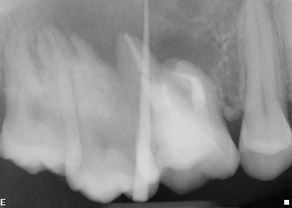Every dentist who is lucky enough to stay in the same practice for many years will be able to see their successful cases come back year after year and will enjoy the great sense of satisfaction and continuity that this gives us. It will also give us the opportunity to see our failures and how we respond to this opportunity probably shapes us more as people and clinicians than any other aspect. It is a certainty right up there with death and taxes that we will all have cases that did not respond the way we expected and the question I pose in the title is the one that I apply to each case. Getting an answer is by no means guaranteed and we just have to accept this sometimes.
The case I show here is a good example of what I am talking about. The molar tooth was root filled a year ago and the tooth responded well to treatment initially. The infection that was present cleared up and the symptoms settled; everything looked fine. Then a week ago I get a call saying the swelling is back and the radiograph I took showed that the infection had not gone away, it had merely become sub-acute but had spent the last 12 months getting progressively bigger.
On the face of it this case should have worked. The patient was a young fit healthy adult; the root filling was done under ideal conditions using all modern techniques such as microscopic vision and illumination, ultrasonics, rotary instrumentation, rubber dam and hypochlorite irrigation and the usual 4 canals were all accessed to a full working length. So why didn’t it? Part of the answer lies in the fact that I am assessing the tooth on a 2 dimensional radiograph when of course it is a 3 dimensional shape so there is plenty of scope for missed anatomy. Part of the answer will lie in the types of bacteria involved – their ability to colonize and survive in root canals, their ability to penetrate the walls of the root canals, their virulence factor etc. Part of the answer lies in the patient’s ability to combat infection and part will lie with the skill and experience of the operator (much as we like to overlook this aspect sometimes!).
Modern endodontics offers great success rates and we are able to restore teeth now that would never have been treated when I first qualified in 1989.The real truth is, sadly that sometimes we just don’t know why a case fails and we need to be always conscious of the chance of this when talking to our patients about possible treatment alternatives. Managing expectations, both our own and our patients, is really important and there should never be any promises of success. I pretty much offer only two guarantees with my work – 1) I will try my very best 2) If I take the tooth out, it won’t grow back. Beyond that there must always be some recognition of the risk of unexpected outcome and a pre-agreed Plan B, just in case!


Root canal fillings continue to give exceptional success and allow us to keep teeth for many years longer than we might have done. We should never be put off treatments because of the occasional disappointments like this but we should use them to make us constantly strive for a better understanding of the treatments which will in turn lead to greater success.